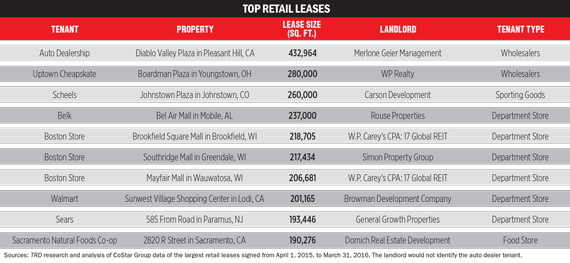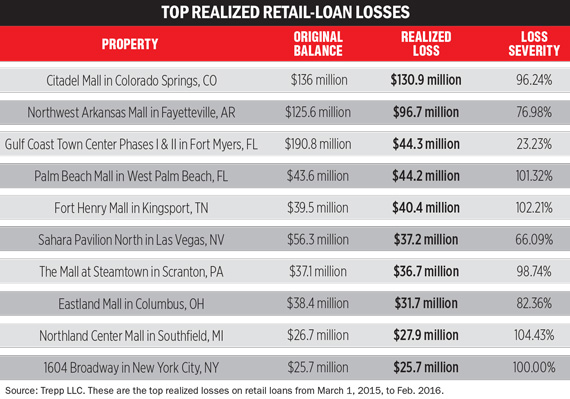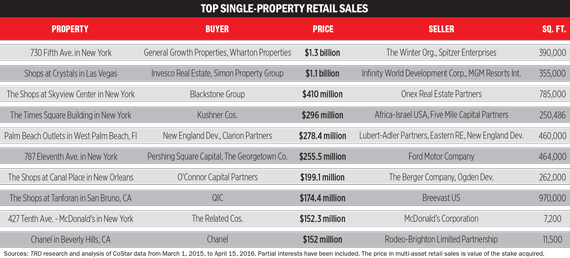Trending
America’s unequal retail recovery
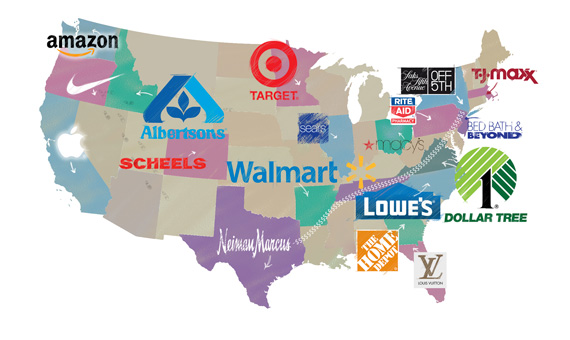
The retail industry continues to mend the wounds incurred during the Great Recession, but the recovery has been anything but evenly distributed across a diverse range of properties in disparate locations.
Not only has the rebound remained uneven; it’s been complicated by a wave of closures of big-box stores that are forcing out once-reliable anchor tenants in struggling malls. That’s been especially painful in more suburban markets grappling with anemic population growth and fierce online competition.
The end result is a market that looks healthy on the upper end but upon closer inspection reveals real challenges and a widening gap between the industry’s trophy assets and those further down the Totem pole.
“It’s really a multi-speed recovery,” said Ryan Severino, senior economist at the commercial real estate research firm Reis. “The tide is raising most ships, but it’s not raising all of them at the same rate.”
On the bright side of the retail industry, dominant high-end malls and shopping centers are crushing it, especially in major metro areas such as New York and San Francisco. In those markets, retail rents are growing at a healthy clip, vacancies continue to edge lower and buyers are paying top dollar for luxury properties.

In April 2015, Jeff Sutton’s Wharton Properties teamed up with General Growth Properties (GGP) to purchase the retail assets at the iconic Crown Building in Manhattan for $1.3 billion. The deal marked the largest retail sale in the U.S. since March 2015, an analysis by The Real Deal shows.
The massive price tag may have been the result of the prime location at 730 Fifth Avenue and the Crown Building’s impressive array of luxury retail brands, including the high-end watchmaker Piaget. The top half of the tower could eventually serve in providing a customer base. That asset was acquired last year by Vladislav Doronin’s Capital Group and Michael Shvo for $475 million and will be redeveloped into luxury homes.
“In some ways the properties at the high end that cater to affluent households have never been stronger,” Severino said.
But the low end of the market that caters to cost-conscious consumers in regions with growing populations has also been showing signs of strength.
Just look at Blackstone Group’s $410 million acquisition last year from Onex RE Partners of the Shops at SkyView Center in New York City’s Queens. With more than 700,000 square feet, SkyView is being billed as the region’s largest mixed-use, multilevel shopping destination and its roster of tenants is led by discount firms such as Target, BJ’s Wholesale Club and the Asian grocery store Sky Foods.
“We’re finding today’s customers are more focused on value than ever before, particularly coming out of a downturn,” Nadeem Meghji, co-head of Blackstone’s U.S. acquisitions, told TRD. “As a result, open-air centers with value-oriented tenants continue to perform and traditional department stores in B malls have suffered.”
The middle of the retail industry looks surprisingly soft. Wage growth for many middle-class Americans has been sluggish at least until recently, making them increasingly likely to turn to online retailers to shop for the best deals. That is a major reason why nearly seven years into the economic expansion, mall vacancies remain at relatively elevated levels.
“The middle-of-the-market households don’t feel like this has been a good economic recovery for them,” Severino said. “They’re still worried about the next recession.”
The Largest Deals
The top acquisitions of the past year illustrate this disparity in the retail business. Preeminent malls in strong markets, especially ones supported by a stream of free-spending tourists, continue to command top dollar.
In December 2015, Centennial Real Estate, Montgomery Partners and USAA Real Estate Company shelled out $1.1 billion to purchase a portfolio of five malls. The trophy asset in the deal was MainPlace Mall in Santa Ana, California, located off the 5 Freeway just 6 miles from Disneyland. The shopping mecca with nearly 200 stores was valued at roughly $354 million in the deal, according to an analysis by CoStar Group.
“It’s a special location,” Steven Levin, CEO of Dallas-based Centennial, told TRD. “The opportunity to buy a dominant asset like MainPlace Mall in Southern California just doesn’t come along but once every generation or so.”
Levin highlighted the fact that innovative malls like MainPlace are adapting to the shifting landscape by learning to rely on new kinds of anchor tenants. For instance, MainPlace not only has traditional anchors such as Nordstrom and Macy’s but also a bowling alley, dozens of restaurants and a 24-hour fitness center.
“The malls are not dying. They are evolving,” Levin said.
Honolulu is another hot tourism and retail market attracting huge investments. Last year TIAA Global Asset Management acquired a 12.5 percent stake in the 2.4-million-square-foot Ala Moana Center for $454 million from majority owner and operator GGP.
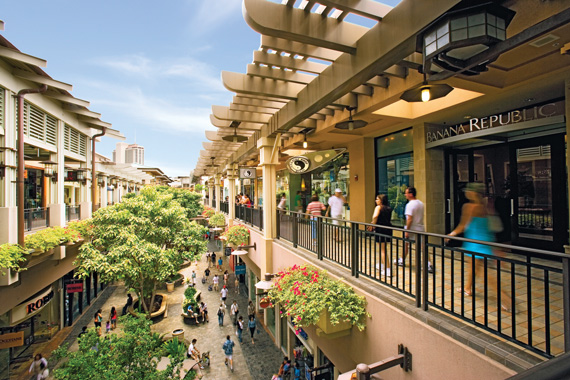
Ala Moana in Honolulu attracts Asia-Pacific visitors who support its rich array of retail stores.
“Any time we have an opportunity to invest in one of these fortress mall assets, we get pretty excited about it,” said Mike Fisk, who heads up acquisitions for malls at TIAA and played a key role in the Ala Moana acquisition.
Fisk said Ala Moana is truly a rare retail asset because it generates a total sales volume of more than $1 billion and more than $1,300 of tenant revenue per square foot. Located in the heart of Waikiki, Ala Moana relies on a reliable flow of visitors from Asia-Pacific countries including China, Japan and Australia to support its wide array of shops, including Nordstrom, Bloomingdale’s, Neiman Marcus, Apple and Louis Vuitton.
“It’s always packed. People tend to be a bit freer with their pocketbooks when they’re on vacation,” Fisk said.
Ala Moana has the added benefit of Hawaii’s restrictive land-use laws that make it very difficult to develop new retail assets. Such supply constraints put a premium on assets that have a long track record of performing well.
Fisk said TIAA wasn’t overly concerned by the recent strength of the U.S. dollar, which companies such as Macy’s and Tiffany & Co. have recently cited as a driver of weaker tourism spending in certain major markets.
“You can’t predict foreign-exchange rates and they change a lot,” he said. “We did study the historical relationship between fluctuations of exchange rates and the impact on sales and found at Ala Moana it was pretty consistent over a 15-year period.”

Jonathan Gray
Meanwhile, Blackstone — with Jonathan Gray heading up its real estate practice — is more focused on the discount market, as evidenced by its acquisition of SkyView in Queens. Managers at the private-equity firm especially like that SkyView has a major grocery store and is located in an area with strong population growth, rising incomes and nearby mass transit.
“Grocery [retail] is more insulated from online,” said Blackstone’s Meghji. “We tend to focus on necessity-based shopping centers that generate repeat visits on a weekly basis.”
Blackstone, which owns 820 retail assets spanning 130 million square feet in the U.S., is also betting on retail assets that offer fashion-brand merchandise to consumers at a value price point. SkyView’s Nordstrom Rack and Marshalls fit that profile.
“People’s mind-sets have changed. Coming out of the recession there appears to be a fundamental shift in behavior, one that is not just cyclical,” Meghji noted. “It’s not that consumers want cheap. They want quality at a good price.”
There are other signs the low end of the shopping spectrum continues to show strong demand.
The Top Tenants
The Chesapeake, Virginia–based discount chain Dollar Tree has leased 2.6 million square feet since March 2015, making it the top retail tenant in the United States over that span, according to the CoStar data. The retailer sells everything from household items to party supplies and holiday decorations. Last year Dollar Tree completed its acquisition of rival Family Dollar Stores, giving the combined company 13,000 stores around the country and sales north of $19 billion a year.
Hobby Lobby, the arts and crafts chain that has more than 600 stores around the country, has leased 2.75 million square feet since March 2015, according to CoStar. Other leading tenants by square footage leased include the retail chain Bon-Ton Stores and Walmart, even though the discount giant is a major owner of real estate too and has been actively closing stores.
A glance at the biggest retail leases for apparel signed over the past year is also telling. Instead of mid-tier brands like Macy’s, that list is led by Uptown Cheapskate, which leased 280,000 square feet near Youngstown, Ohio, and opened for business there in March. As its name implies, Uptown Cheapskate is a fashion reseller that pays shoppers cash for their designer clothes and then resells them at a discount as much as 90 percent off retail prices.
The sporting goods industry is also dealing with a shifting landscape, especially given the recent struggles of Sports Authority. The retailer filed for bankruptcy earlier this year and announced plans to close 143 stores across the country, including three in Colorado.
At least one smaller player plans to fill the void in Colorado. Last year North Dakota–based sporting goods and entertainment chain Scheels signed a 260,000-square-foot lease there in Johnstown.
The new Scheels is set to open next year and will feature more than 85 specialty shops, including ones that cater to golfers, bikers, hunters and fishers. The Johnstown Scheels will try to attract shoppers by showcasing a 65-foot Ferris wheel, shooting galleries and a 16,000-gallon aquarium.
The Biggest Struggles
Still, there are clearly pockets of weakness in the American retail landscape. Competitive pressures from Amazon and other e-commerce players have helped fuel store closures, including once-reliable mall anchors like Macy’s, J.C. Penney and Sears.
“The ones really in the crosshairs are the middle-of-the-road centers that cater to mid-tier households who tend to be pretty price sensitive,” said Reis’ Severino.
The store closures have been widespread, but they have been more common and painful in less urban areas.
“Where there is less population density, retailers are not seeing the same value in keeping a physical storefront,” said Ryan McCullough, senior real estate economist at CoStar. “The economics of being in less dense areas are not what they used to be.”
Given the fact that e-commerce continues to steal a larger slice of the overall retail pie, the onus is on traditional malls and retailers to adapt.
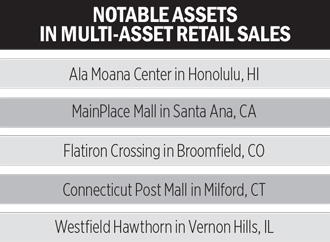 “Landlords and retailers are going to have to do a better job of using their Internet presence and bricks-and-mortar presence together,” Severino said. “If you don’t get that strategy right and someone else does, they’re going to leave you behind.”
“Landlords and retailers are going to have to do a better job of using their Internet presence and bricks-and-mortar presence together,” Severino said. “If you don’t get that strategy right and someone else does, they’re going to leave you behind.”
Financial Implications
In the worst case, getting left behind can mean financial trouble like loan defaults or even bankruptcy. Sean Barrie, a research analyst at Trepp, said the retail assets most at risk are ones located in suburban markets that rely on struggling big-box retailers.
“It’s a snowball effect,” he told TRD. “If you’re not generating sufficient occupancy, you’re not getting enough revenue and you may have to raise rents. More tenants could start to leave, sending cash flows and revenue tumbling.”
Last year Northwest Arkansas Mall in Fayetteville, Arkansas, defaulted on more than $125 million of debt after five straight years of revenue declines, according to Trepp. The indoor mall is anchored by struggling stores like J.C. Penney and Sears and also includes teen apparel retailer Abercrombie & Fitch, which has been mired in its own slump.
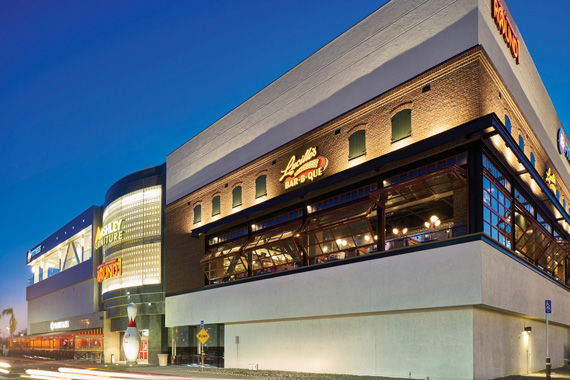
MainPlace Mall in Santa Ana hosts dozens of restaurants, a bowling alley and a 24-hour fitness center.
Earlier this year special servicer CWCapital sold Northwest Arkansas Mall to three investment groups for $39.5 million, just a fraction of the $150 million it had fetched a decade earlier, according to news reports. None of the parties involved in the deal responded to a request for comment.
Despite a number of major defaults over the past year, Barrie said, overall delinquency rates in retail continue to decline and credit quality is up dramatically from the last cycle.
“It’s really night and day,” he said. “Before the recession, loans were getting priced into deals that had no business being there. From that perspective, retail is much healthier than it was before the recession.”
Leasing Outlook
Regional and super regional mall vacancy rates stood at 7.8 percent as of the first quarter, down from a peak of 9.4 percent in 2011, according to data from Reis. That is still well above the pre-recession low of 5.1 percent in early 2005, however.
Mall landlords have experienced just modest increases in rent, with asking rents rising 2.2 percent in the first quarter compared with the same period last year. That matches the rate of core inflation over the past 12 months as of the end of March.
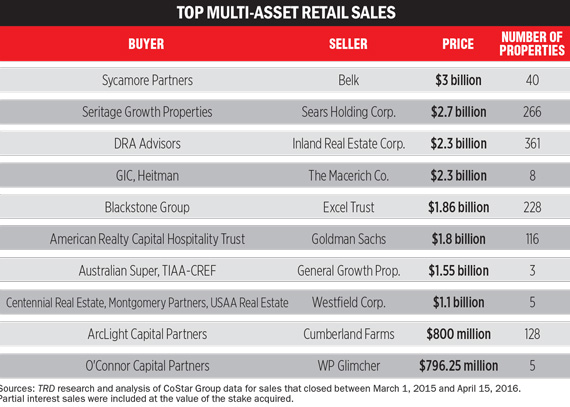
(Click to enlarge)
Some metro markets have enjoyed higher growth in rents than their peers. For the first quarter, the growth in 12-month asking retail rents was more than 4 percent in Charleston, South Carolina; San Jose, California; Austin, Texas; and Miami, Florida, according to Reis. In comparison, markets like central New Jersey; suburban Maryland; Little Rock, Arkansas; and Rochester and Buffalo, New York, have all had stable rent growth of 1.2 percent or less.
Likewise, according to Reis, the markets experiencing the largest 12-month vacancy rate increases include the mostly suburban areas of Fairfield County, Connecticut; New York’s Long Island; northern New Jersey; Richmond, Virginia; Wichita, Kansas; and Ventura County, California.
“When you look at suburban areas that got a lot of the building in previous cycles, there’s really just no activity going on out there. Rent growth has only recently flipped positive and it’s still quite weak,” said McCullough. “Retailers interested in the path of growth are wise to be aiming at the urban market.”





